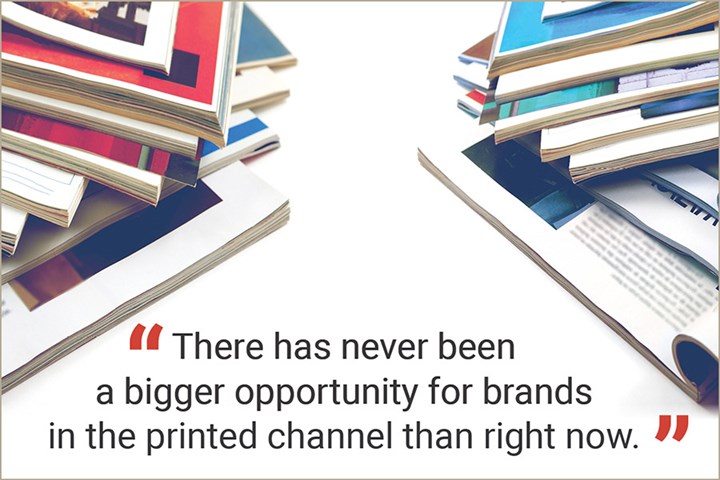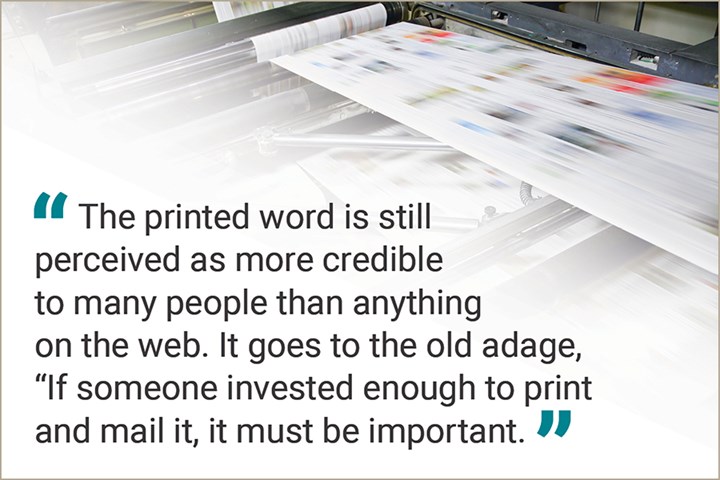Time to Rethink Print?
Here are a few reasons why there has never been a bigger opportunity for brands in the print channel than right now.
By Joe Pulizzi, Content Entrepreneur
A few weeks ago I took a Zoom call with a marketing director at a large manufacturer. They wanted to do something different with their marketing. They wanted to create something that would engender real loyalty with their customers and present their company as a thought leader in the industry. And something that would truly capture attention over a long period of time.
I asked if they considered publishing a print magazine. Not a catalog, but a valuable and educational magazine to their customers.
After a few seconds of silence, the marketing director asked why.
I know what you are thinking. Out of all the content distribution options out there, from TikTok to YouTube to email newsletters, why in the world would a company consider a print magazine?

It’s funny, when I started in media, print was considered traditional marketing, while blogging and social media were non-traditional. Today, these have most definitely flipped.
Now, am I saying that brands should be looking at print as an opportunity right now to get and keep attention? Yes, that’s exactly what I’m saying.
The Death of Mainstream Print
Last year, Dotdash Meredith announced they were ceasing publication on six major magazine brands, included Entertainment Weekly, InStyle and Parents magazine. And the list of popular magazines that are now dead would take weeks to recount, including Newsweek, MacLife and SmartMoney.
When I have conversations with marketers and publishers about these kinds of moves, I always hear the notion that “print is dead.” Well, I’m here to tell you that there has never been a bigger opportunity for brands in the printed channel than right now.
While I would not want to be in the broad-based, horizontal print game (ala USA Today), highly-niche, highly-targeted publications can flourish as a marketing tool. Just ask LEGO, who has been producing a bi-monthly print magazine for customers and fans since 1987.
Six Reasons to Rethink Print
Here are a few reasons why there might be an amazing opportunity in the print channel:
1. It grabs attention: Have you noticed how many fewer magazines and print newsletters you are getting in the mail these days? I don’t know about you, but I pay more attention to my print mail. There’s just less mail, so more attention is paid to each piece. Opportunity? The decisions that traditional magazines are making leave a clear opportunity for content marketers to fill the gap.

2. Its focus on customer retention: According to the Content Marketing Institute, Sixty-four percent of B2B marketers create original content for customer retention and loyalty goals. Historically, the reason why custom print magazines and newsletters were developed by brands was for customer retention purposes. If you have a goal to get and keep customers, print should be top of mind.
3. There are no audience development costs: Publishers expend huge amounts of time and money qualifying subscribers to send out their magazines. Many times, publishers need to invest multiple dollars per subscriber per year for auditing purposes (They send direct mail, they call… they call again… so that the magazine can say that their subscribers have requested the magazine. This is true for controlled [free] trade magazines).
So, let’s say, a publisher’s cost-per-subscriber per year is $2 and their distribution is 100,000. That’s $200,000 per year for audience development.
That’s a cost that marketers don’t have to worry about. If marketers want to distribute a magazine to their customers, they just use their customer mailing list. That’s a big advantage.
4. Customers still need to know what questions to ask: We love the internet because buyers can find answers to almost anything. But where do we go to think about what questions we should be asking? I talked to a publisher who said this:
“The web is where we go to get answers but print is where we go to ask questions.”
The print vehicle is still the best medium on the planet for thinking outside the box and asking yourself tough questions based on what you read — it’s lean back versus lean forward. If you want to challenge your customers, print is a viable option.

5. Print still excites people: I talked to a journalist recently who said it’s harder and harder to get people to agree to an interview for an online story. But mention that it will be a printed feature and executives rearrange their schedule. The printed word is still perceived as more credible to many people than anything on the web. It goes to the old adage, “If someone invested enough to print and mail it, it must be important.”
7. Print lets people unplug: More and more, people are actively choosing to unplug, or disconnect themselves from digital media. I’m finding myself turning off my phone and email more to engage with printed material. Today, I relish the opportunities when I can’t be reached for comment.
If I’m right, many of your customers (especially busy executives) are feeling the same way. Your print communication may be just what they need.
Online content creation is definitely here to stay. So say “yes” to social media, apps, and the rest of it. But don’t forget that print can still play an important role in your overall content marketing mix.
Joe is author of Content Inc. and Epic Content Marketing.
Need more information?
Joe Pulizzi
joepulizzi.com
About the Author
Joe Pulizzi
Joe Pulizzi (he/him) is founder of multiple startups including content creator education site, The Tilt, the content entrepreneur event Creator Economy Expo (CEX), and is the bestselling author of seven books including Content Inc. and Epic Content Marketing, which was named a “Must-Read Business Book” by Fortune Magazine.
Joe is best known for his work in content marketing, first using the term in 2001, then launching Content Marketing Institute and the Content Marketing World event. In 2014, he received the "Lifetime Achievement Award" by the Content Council. He successfully exited CMI in 2016 and consequently wrote an award-winning mystery novel, The Will to Die.
He has two weekly podcasts, the motivational Content Inc. podcast and the content news and analysis show This Old Marketing with Robert Rose.
His foundation, The Orange Effect, delivers speech therapy and technology services to more than 350 children in 35 states.
Joe and his family live in Cleveland, Ohio.
RELATED CONTENT
-
How to Make Your Print Ad Stand Out
When trying to decide what the best path of attack is for your business’ marketing and advertising, remember that you have options. Here are some problems you might have encountered before, coupled with some actionable ways to solve them.
-
Marketing Messages That Cut Through The Noise
We’ve talked about customer journeys, emotional intelligence, and finding and retaining customers. You’ve tuned up your marketing messages. Now it’s time to decide where to place them, so customers tune in. In a world with endless channels of information, how do you become a source of knowledge — not noise? One step at a time.
-
The Fisherman Approach to Print Advertising
Hook-less ads are a waste of money. Trade magazines with lots of information-hungry readers represent oceans of possibilities. You just need to know which bait to use. Here are some ideas to stop readers and reel them in.


